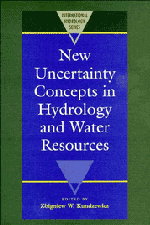Book contents
- Frontmatter
- Contents
- List of Authors
- Preface
- I INTRODUCTION
- II FACETS OF UNCERTAINTY
- III NOVEL APPROACHES TO UNCERTAINTY: FRACTALS, FUZZY SETS AND PATTERN RECOGNITION, NON-PARAMETRIC METHODS
- IV RANDOM FIELDS
- 1 Analysis of regional drought characteristics with empirical orthogonal functions
- 2 Worth of radar data in real-time prediction of mean areal rainfall by nonadvective physically-based models
- 3 Uncertainty analysis in radar-rainfall estimation
- 4 Design of groundwater monitoring networks for landfills
- 5 Spatial variability of evaporation from the land surface – random initial conditions
- 6 Detecting outliers in flood data with geostatistical methods
- V TIME SERIES AND STOCHASTIC PROCESSES
- VI RISK, RELIABILITY AND RELATED CRITERIA
6 - Detecting outliers in flood data with geostatistical methods
Published online by Cambridge University Press: 07 May 2010
- Frontmatter
- Contents
- List of Authors
- Preface
- I INTRODUCTION
- II FACETS OF UNCERTAINTY
- III NOVEL APPROACHES TO UNCERTAINTY: FRACTALS, FUZZY SETS AND PATTERN RECOGNITION, NON-PARAMETRIC METHODS
- IV RANDOM FIELDS
- 1 Analysis of regional drought characteristics with empirical orthogonal functions
- 2 Worth of radar data in real-time prediction of mean areal rainfall by nonadvective physically-based models
- 3 Uncertainty analysis in radar-rainfall estimation
- 4 Design of groundwater monitoring networks for landfills
- 5 Spatial variability of evaporation from the land surface – random initial conditions
- 6 Detecting outliers in flood data with geostatistical methods
- V TIME SERIES AND STOCHASTIC PROCESSES
- VI RISK, RELIABILITY AND RELATED CRITERIA
Summary
ABSTRACT The plausibility analysis of the regional flood data of Southern Norway is performed with the help of geostatistical methods. As the data at a number of sites are analyzed, one can account the spatial relationships in the outliers detection problem. That is the results of outliers detection may differ in comparison to the non-structured (univariate) case. The geostatistical methods applied are block kriging and Switzer's location-specific covariance analysis, with catchment areas accounted.
INTRODUCTION
An intuitive definition of an outlier can be ‘an observation which deviates so much from other observations as to arise suspicions that it was generated by a different mechanism’ (Hawkins, 1980). An outlying observation can be interpreted in several ways. It may represent an event of extreme magnitude (e.g. due to rare natural causes) that has unexpectedly happened in the system. In flood frequency analysis such extreme events are of outmost importance, indicating a heavy right tail of the parent distribution. On the other hand, a value differing from the remainder of the data set may be an erroneous observation. This could have been caused by instrument malfunctioning or human mistakes (e.g. at the stage of interpretation of the rating curve for high flows). In this latter case outliers may contaminate the data and reduce the useful information about the natural process.
Detection of outliers in hydrological data can be performed in a number of ways. Kottegoda (1984) considered approaches based either on distributional, mixture, or slippage alternatives for investigation of a series of maximum annual flows.
Information
- Type
- Chapter
- Information
- New Uncertainty Concepts in Hydrology and Water Resources , pp. 206 - 214Publisher: Cambridge University PressPrint publication year: 1995
Accessibility standard: Unknown
Why this information is here
This section outlines the accessibility features of this content - including support for screen readers, full keyboard navigation and high-contrast display options. This may not be relevant for you.Accessibility Information
- 2
- Cited by
